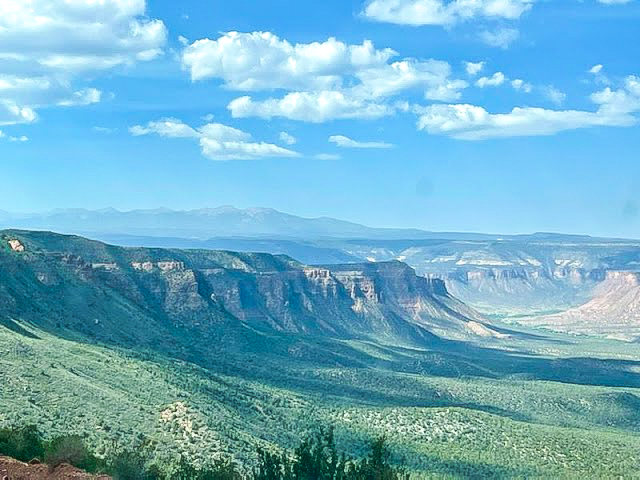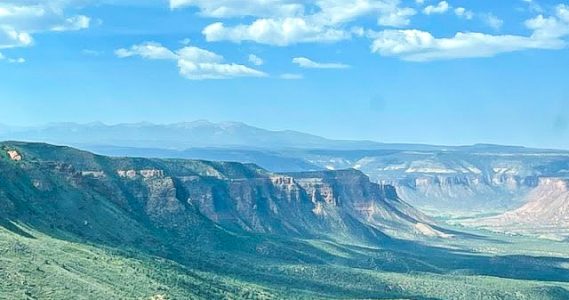Calamity Camp, CO 2024
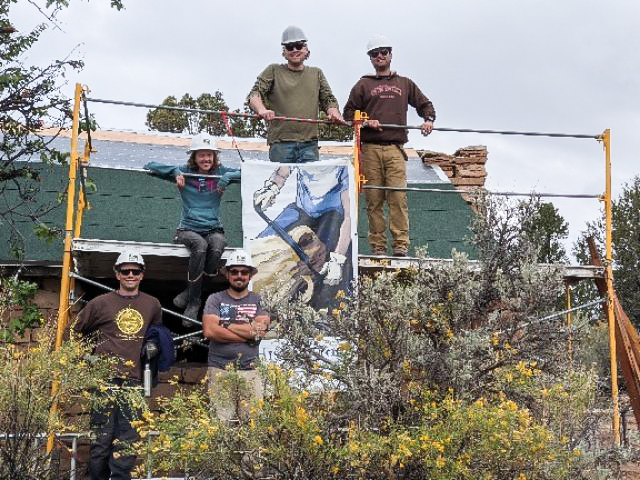
From the early 1900s until the 1960s, radium, vanadium, and uranium mining boomed on Colorado’s western slope. Calamity Camp survives as a popular tourist stop for historians looking for a “miner detour.”
PROJECT PARTNER: Bureau of Land Management
SESSION DATES: June 9-14
PROJECT SUPERVISOR: Sarah Mees!
CREW LEADER: Leisa Grant!
Project Site Description & History
On the western slope of Colorado you’ll find epic mesas, towering mountain ranges, and among other things, a rich mining history. Calamity Camp outside of Gateway, CO is located on the Uncompahgre Plateau and was established sometime between 1915 and 1925. Featuring five rock cabins, a bunkhouse, cellars, horse corrals, and a rock and cedar post barn, the camp is one of many pieces of mining history laced throughout southwestern Colorado.
Located on historically Ute land, miners extracted uranium, vanadium, and radium from Calamity Mesa from 1916-1980. Uranium is found in several places around Colorado, but 77% of the state’s uranium and vanadium is found in “numerous and relatively small mines in the Uravan mineral belt located in Mesa, Montrose, and San Miguel Counties” (Colorado Geological Survey). Colorado’s last uranium mine closed in 2005. Today, uranium is used in many industries, especially nuclear power generation. Historically, though, its use was primarily military. During WWI, molybdenum (“Molly B”), which was also mined in Colorado, was critical to the weapons manufacturing (primarily artillery guns and weapons requiring strengthened steel).
When the Central Powers suffered a shortage of molybdenum, they turned to ferrouranium alloys as a substitute. Hence, uranium mining became an important part of the war effort. This use of uranium continued until WWII’s Manhattan Project, and later Cold War, which instead required significant quantities of uranium for fission research and nuclear weaponry (learn more). By the 1980s, however, demand for uranium was down and Calamity Camp became a ghost town.
Uranium mining touches on almost all aspects of society, from warfare, to economics, to health, to social discrimination, to justice. Looking at the impact of uranium extraction through the lenses of public health and environmental justice can offer a critical perspective on this broad topic. As a starter read, check out the 2019 AP article “Mining camp alive in memories of Navajo uranium victims” and go deeper with Brugge and Goble’s 2002 article, “The History of Uranium Mining and the Navajo People,” And, you can dig into the Radiation Exposure Compensation Act (RECA) to learn how the Department of Justice is handling compensation for victims of the externalities of uranium mining.
In 2007, the BLM, in partnership with the Museum of Western Colorado and the Gateway Canyons Resort, worked to stabilize and protect some of the camp’s buildings and structures. Four years later, the site was placed on the National Register of Historic Places. By preserving Calamity Camp, we ensure future generations can continue to learn from the legacy of uranium mining activities in Colorado. Today, the site is located near splendid Western Slope recreational opportunities, including Jeeping, hiking, mountain biking, and more. HistoriCorps invites you to join us for our return trip to Calamity Camp as we get back to work on two of the remaining stone cabins and dig in for another historic season of preservation work.
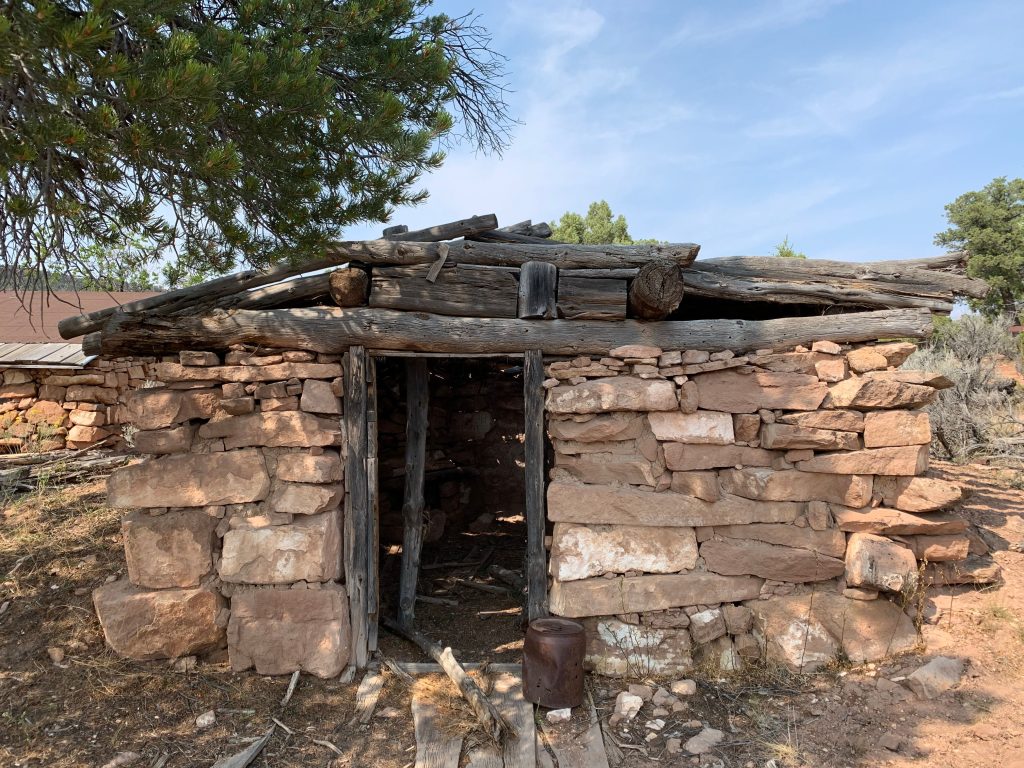
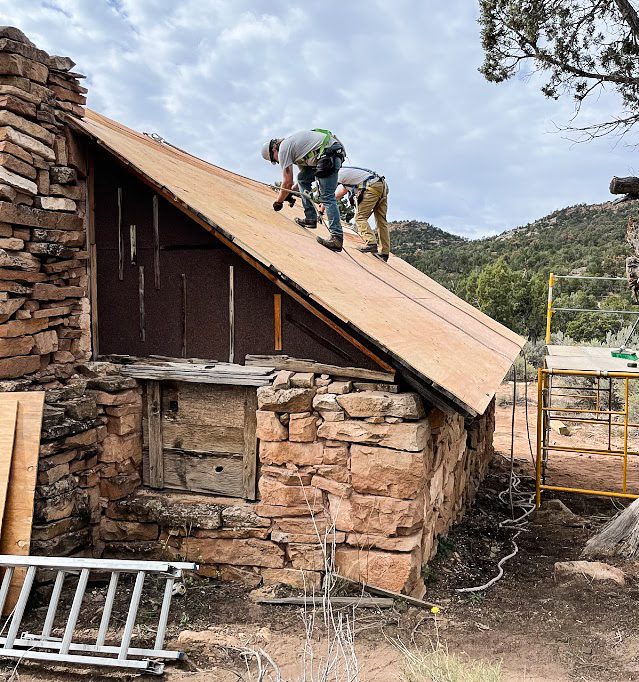
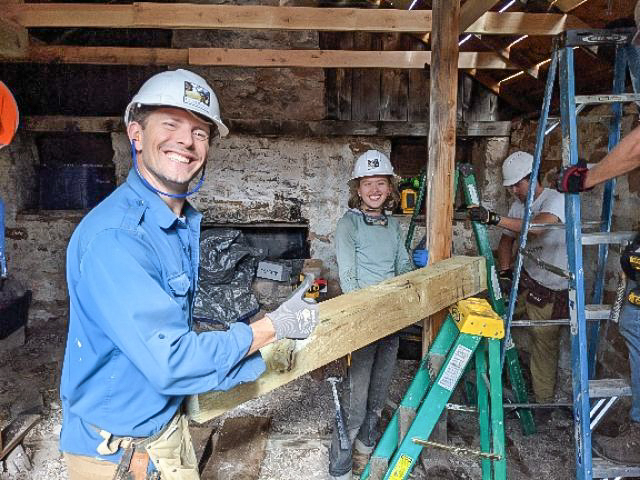
Check out our video from 2021 about Calamity Camp!
Check out this informative lecture on Calamity Camp by Mesa County Libraries Historian Ike Rakiecki!
Location and Logistics
SESSION DATES: May 26-31, June 2-7, and June 9-14
Please arrive at the campsite no earlier than 5pm and no later than 7pm on the first day of your session.
LOCATION: Located roughly 50 minutes outside of Gateway, CO.
MAP to CAMP SITE
MAP to CALAMITY CAMP
CAMPSITE INFORMATION:
![]()
![]()
![]()
Hi-clearance vehicles with 4WD are recommended! Tent campers will have access to your campsite. Showers are not available and dogs are allowed but must be leashed.
WEATHER: Anticipate highs in the 70s and lows in the 50s. Weather conditions may be rainy, cloudy, or sunny. Volunteers are responsible for checking weather conditions before their session begins, and packing appropriately.
ABOUT VOLUNTEERING: HistoriCorps projects are free for volunteers! HistoriCorps will provide all meals, tools, training, equipment, and a campsite. Volunteers are responsible for their own transportation to the campsite, sleeping equipment, work gloves, clothes and boots, and other personal gear.
Scope of Work
HistoriCorps is committed to educating and training volunteers in preservation skills, with an overarching mission of inspiring a preservation ethic in all those involved. Learning and working alongside expert HistoriCorps field staff, volunteers and applying the traditional skills necessary to restore the buildings of Calamity Camp:
- Maintain building exteriors
-
Repair roof structures and stabilize walls
-
Stabilize and re-stack fireplaces as necessary
Please note: Tasks vary by day and by week, depending on a variety of factors including: weather, project priorities, previous groups’ work, and more. Though it is likely you will get to learn and practice most or all of the above tasks, it is not guaranteed. The higher percentage of the scope a particular task is, the more likely you will get to practice it.
Sign Up!
We’re thrilled this project has inspired you to volunteer!
CLICK HERE TO REGISTER!
Visit our Job Calendar to see spaces are available!
*All registrations submitted to projects at capacity will be automatically added to our waitlist.*
CANCELLATIONS effect our ability to complete projects. Please register only if you are certain about your ability to participate.
You will know your registration was successful when you receive a confirmation email. Contact volunteer@historicorps.org for assistance.
HistoriCorps does not charge for its volunteering projects. HistoriCorps relies on donations to continue engaging volunteers to save significant historical sites across America for generations to come. Your donation of any amount will make an incredible difference! Increase your impact – make a generous gift today.
Volunteer Logistics, Policies, and Advice
We’re so glad you’re interested in joining this project! If you’re new to our community, review the Volunteer FAQ first! Please note the following logistics and policies:
- Volunteering with HistoriCorps is free! We will provide all meals, tools, training, equipment, and a campsite or shared indoor lodging. Dinner is not provided on the first night.
- Volunteers are responsible for bringing their own gear, work gloves, sturdy work clothes and boots, and appropriate sleeping equipment. Check the average temperatures before you start packing – the nights and mornings may be colder than you anticipate! Then, read this advice about how to stay warm when tent camping in colder places.
- Campsite accessibility varies by project. Some projects can accommodate tents only; others can accommodate small RVs. Please review the project site description above for more information, and if you’re still not sure, email volunteer@historicorps.org for help.
- If this project does not offer showers, you might want to consider bringing a solar shower or research other methods to clean up after the work day.
- Volunteer crew sizes generally range from 4-8 volunteers, with two HistoriCorps staff that lead and train volunteers in the work.
- Safety is one of HistoriCorps’ top priorities, and volunteers can contribute to a safe working environment by ensuring their physical fitness is adequate for the work. See above for this project’s scope of work and difficulty level. Please, call us if you are not quite sure if a project is a good fit for your skills or fitness level. We may be able to suggest a project more suitable and enjoyable for you.
- Hard hats, eye protection, ear protection, gloves are standard personal protection equipment (PPE) required on all projects. Hard hats must be worn at all times on the project site, unless working in a designated safe space. Field staff will train volunteers on correct use of PPE.
- Dogs are generally allowed to accompany their humans in project campsites (actually, we love having dogs join us around the campfire!). Dogs are not permitted on the job site for everyone's safety. HOWEVER: HistoriCorps also follows the rules and regulations of our project partner. If the project partner does not permit dogs onsite then HistoriCorps is no exception. Please ask HistoriCorps or the project partner directly if you have any questions about whether Fido is welcome.

